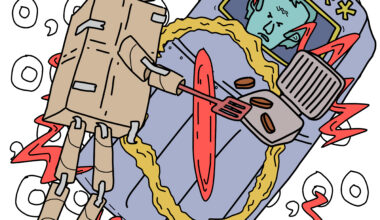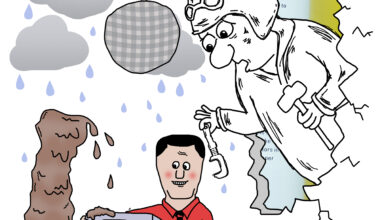Our esteemed columnist eats too much cheese before bed (again) and lucky for us he writes down all his dreams. This is the only one we can print without having him arrested…

The ruddy man in the cardigan flattens his comb-over then sips from a cup of tea. The cup has a picture of his face and the words “Factory Manager Of The Year”. As the man leans back in his office chair, his real face looks smug. He’s justified, because this is Arthur Drainthwaite, saviour of electronic music.
“We set up Wax Emissions because the kids were going mad for records. Actual vinyl records,” says Arthur.
“I’ve seen the local teenagers round the back of Asda snorting nitrous oxide and throwing mp3s into the bin. They want real music, like the olden days. When gramophones were gramophones.”
Wax Emissions is now the 17th largest vinyl processing plant in northern Cumbria, outside of Carlisle. Arthur takes me on a tour of the plant, a cobwebbed building that used to be a Greggs.
“The place still stinks of meat and potato,” he says as we walk the corridors. The walls are lined with photos.
“That’s young Barney,” Arthur says, pointing at one as we pass by. “He’s a lad that used to work here. Fell into the spooling mechanism. Came out as human spaghetti, very tragic.”
It’s actually a glossy press photo of Gary Numan. I decide not to correct him. On the ground level of the processing plant, they collect music to put onto the records. A trestle table heaves from Ikea storage boxes filled with minidiscs, DAT tapes and printed-out MySpace pages.
“Among this lot is Jive Bunny’s techno album,” says Arthur, casting a hand vaguely over the boxes. “It’s a little bit acid house.”
Down some narrow stairs is the vinyl mixing area, where they make the actual vinyl. Arthur won’t say how dance records are made because it’s a trade secret like Coca Cola, Blackpool rock and Ed Sheeran.
“If I gave away my secrets,” he says, “this wouldn’t be the 17th largest vinyl processing plant in northern Cumbria, outside of Carlisle.”
Below this are dozens more underground levels, all the same as each other. Why so many identical levels? Because this column is only one page and I need to crack on to the end. The grooves for 12-inch records are made on these floors. Arthur tells me all this space is needed because before they’re twisted into a spiral, grooves are very long.
Finally we reach the lowest basement, a mile underground. In this cold, cluttered space, the music and the vinyl and the grooves are joined together to create the electronic hit singles of the future. There is stuff everywhere: records line the walls and shards of beef pasty are strewn underfoot.
When Arthur pulls on a rope, I discover how they send completed records up to the ground level for distribution to record shops. “Is that a lever and pulley system?” I remark. Arthur gives a proud smile and nods. He’s a genius, I decide. The concrete floor beneath the winch is littered with shattered vinyl. One triangular segment shows a printed label. The letters say “…LUE MONDAY…”It’s obviously a partial title of a 12-inch single made down here. Without the full wording, I’ll never know what it was, such is the enduring mystery of Wax Emissions, the 17th largest vinyl processing plant in northern Cumbria, outside of Carlisle.





